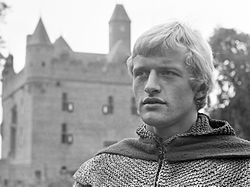| Episode Number | Name | Original Release Date [4] | Summary |
|---|
| 1 | Het gestolen kasteel (The Stolen Castle) [5] | October 5, 1969 | Floris van Rosemondt returns home after years of traveling to claim his inheritance: a castle. However, it is being used as a tollhouse by Maarten van Rossum. Maarten van Rossum has Floris and his companion Sindala imprisoned under the pretense of espionage for Wolter van Oldenstein. Wolter arrives to rescue them. |
| 2 | De koperen hond (The Copper Dog) | October 12, 1969 | Oldenstein is under siege by Van Rossum, who brings in a massive cannon called the Copper Dog. Floris and Sindala, who are outside the castle, must find a way to sabotage it. |
| 3 | De zwarte kogels (The Black Bullets) | October 19, 1969 | During an ambush on a weapons transport, it becomes clear that there is a traitor inside Oldenstein Castle. Sindala comes up with a plan to unmask the traitor. |
| 4 | De man van Gent (The Man from Ghent) | October 26, 1969 | A man from Ghent named Gwijde van Suikerbuik arrives at Oldenstein with news that Van Rossum is planning to attack Oudewater. Lord Wolter sends reinforcements. Meanwhile, the bandit Lange Pier is supposedly heading to plunder the chapel, prompting Wolter and Floris to leave with their last soldiers. Sindala stays behind with Suikerbuik. |
| 5 | De harige duivel (The Hairy Devil) | November 2, 1969 | When Philip the Handsome buys The Temptation of St. Anthony from the artist Hieronymus Bosch, Charles of Guelders sets his sights on the artwork. Lange Pier tries to steal the painting, despite being terrified of all the little devils depicted on it. In return for helping him make safe passage to Philip the Handsome, Bosch creates a new painting for Floris and Sindala, The Pedlar . |
| 6 | De vrijbrief (The Pass Papers) | November 9, 1969 | Floris and Sindala are allowed into the city of Guelders with a safe conduct pass for the day to carry out the business of buying a suit of armor. Sindala starts to sense something is off. |
| 7 | De drie narren (The Three Fools) | November 16, 1969 | Floris and Sindala must deliver an urgent letter to Utrecht, but it first needs to be sealed by commander Reinbout. Upon arriving at his castle, they find it ransacked by Van Rossum. Everyone has been taken, except for the court jester. Together with the jester, they devise a plan to rescue Reinbout. But the Guelders captain Barend van Hackfort is also lurking nearby. |
| 8 | De alruin (The Mandrake) | November 23, 1969 | A grand feast is held for Lord Wolter Oldenstein’s birthday. When Van Hackfort manages to sneak into the kitchens and poisons the soup, the entire castle is drugged—except for Floris and Sindala, who must quickly find an antidote. |
| 9 | Het brandende water (The Burning Water) | November 30, 1969 | After the death of her uncle, Countess Ada of Couwenberg comes into possession of an important will. Charles of Guelders wants it too, so Lange Pier captures the countess. Luckily, Floris and Sindala are nearby. |
| 10 | De wonderdoener (The Miracle Man) | December 7, 1969 | Veltman wins over the whole town with his so-called miracle potions. Van Rossum pressures him to incite the people against Oldenstein. Veltman, who has a score to settle with Sindala, gladly agrees. |
| 11 | De Byzantijnse beker: Het toernooi (The Byzantine Goblet: The Tournament) | December 14, 1969 | In a Guelders castle, Lady Isabella lies dying. Her suitors, Govert and Roland, try to cure her to win her hand. They hear about a tournament at Oldenstein where a miraculous cup can be won. Both men try to get their hands on it—though Govert plays dirty. |
| 12 | De Byzantijnse beker: De genezing (The Byzantine Goblet: The Healing) | December 21, 1969 | When Roland wins the tournament, Govert ambushes him and steals the cup. Floris and Sindala find the wounded Roland and decide to help. But their attempt to rescue Isabella from Govert’s clutches fails. |
| 13 | Het Gericht (the tribunal) | August 19, 2016 | In 2016, raw footage was found from this unfinished episode. The tribunal was assembled, and ran just over 18 minutes when linked with panels from the newspaper comic strip and narration where necessary to make up for the missing material. It was then shown at Doornenburg Castle, one of the original filming locations. [6] All the material of both unfinished episodes was later made available online through a regional Guelders broadcaster. [7] [8] |
| 14 | De Bouwmeester (The Architect) | 2016 | Only a few minutes of the episode was found in 2016. |
